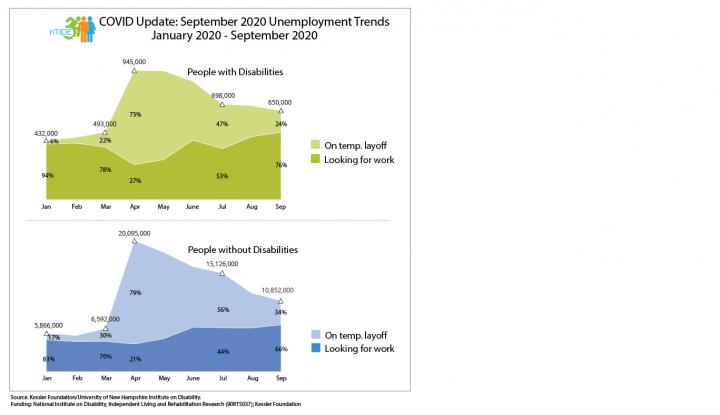As the pandemic persists, furloughs are converting to job losses for many workers, increasing the number of people actively looking for work, a trend that may reflect ongoing economic challenges

Credit: Kessler Foundation
East Hanover, NJ. October 30, 2020. Since the peak of unemployment seen in May 2020, unemployment has gradually declined for people with and without disabilities. A closer look reveals the details underlying this trend, and the implications for both groups and the ongoing impact of the COVID-19 pandemic on the U.S. economy.
An ongoing shift from furloughs to looking for work underlies the decline in unemployment, which does not bode well for workers. “As reported in our September 18 COVID update, the numbers support a slowing of the economic recovery,” says economist Andrew Houtenville, PhD, research director of the University of New Hampshire Institute on Disability.
Comparing people with and without disabilities, the outlook is worse for workers with disabilities. “The number of workers with disabilities on furlough has dropped to one out of four,” Dr. Houtenville emphasized, “and three out of four are now actively looking for work.”
The trend is not unexpected, given the uptick in new COVID infections in many areas of the country. The pattern of wide geographical variations continues, with the upper Midwest experiencing the latest sharp increases in cases. The numbers warrant close observation, according to Dr. Houtenville. “Good public health is fundamental to a good economy. If this pattern persists, the adverse effects on local economies will contribute to more job losses and increase the proportion of people looking for work,” he said.
There is some positive news in the labor force participation rate, which has remained stable for people with disabilities, according to Dr. Houtenville. “This indicates that so far, they have not dropped out of the labor market. How long people with disabilities stay engaged in the labor market depends on a number of unknown variables such as the possibility of future stimulus packages and the course of the pandemic ”
The pandemic has had a chilling effect on new employment for people with disabilities according to the recent survey by APSE (Association of People Supporting Employment First).”This survey of 600 disability service organizations showed an initial drop in referrals to vocational rehabilitation and a decrease in Medicaid reimbursement,” commented John O’Neill, PhD, director of the Center for Employment and Disability Research at Kessler Foundation, “two dramatic declines reflecting the impact on transition to work.” Those with jobs fared better. “The 42% of APSE members who received loans through the Payroll Protection Plan were able to maintain staff to help keep workers with disabilities in their jobs,” noted Dr. O’Neill, “and we saw a quick rebound in job support services among service providers.”
As the pandemic continues to buffet the economy. Drs. Houtenville and O’Neill will closely monitor the job numbers, issuing semi-monthly reports – our traditional first Friday jobs report, and this mid-month COVID update.
###
This COVID Update is an extra edition of National Trends in Disability Employment (nTIDE), a joint project of Kessler Foundation and the University of New Hampshire Institute on Disability, co-edited by Drs. O’Neill and Houtenville. Register for our November 6 nTIDE at https:/
Interested in trends on disability employment? Contact Carolann Murphy to arrange an interview with our experts: [email protected].
Register for our November 6, 2020 nTIDE Jobs Report, and our November 20, 2020 COVID Update at https:/
Media Contact
Carolann Murphy
[email protected]




